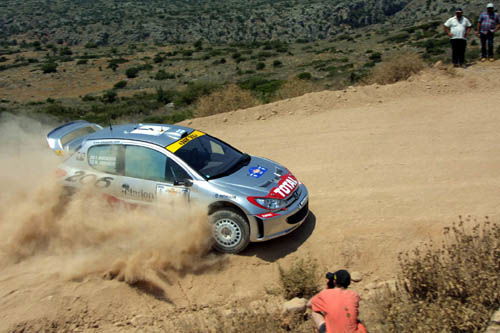Mitsubishi drivers no head cases.
Back in the 1920s, crash helmets were only ever worn by racing motorcyclists and, even though a few motor racing drivers made early adaptations, head protection was not widespread for many years.
In fact, it was not until the early 1950s that the flying cap finally gave way to mandatory protective helmets.
Back in the 1920s, crash helmets were only ever worn by racing motorcyclists and, even though a few motor racing drivers made early adaptations, head protection was not widespread for many years.
In fact, it was not until the early 1950s that the flying cap finally gave way to mandatory protective helmets.
These days the specification is high tech and the materials used by the leading manufacturers come from the aerospace industry, forming an integral part of a driver's safety equipment. Plain white helmets are also a thing of the past, most competitors - including the Marlboro Mitsubishi Ralliart drivers - taking the opportunity to sport personalised designs that not only reflect their nationality and personality, but also accommodate the all-important sponsors.
Essentially, the crash helmet is worn to protect the brain from injury, offering little protection to facial bones and tissue or the neck, all of which come under the title of 'head'. When the head is banged, the brain is shaken up inside and, in the absence of a fracture of the skull, the damage is largely caused by the sharp internal edges of bone cutting into the brain surface. Apply a force to the skull and it deforms by about half an inch before cracking up. The force necessary to perform this is in the region of 5000lbs and, if the average head weighs approximately 10lbs, this force is equivalent to 500 times the force of gravity (G). If an unprotected skulls hits a solid, flat surface at only 12mph, the deceleration imparted to the brain is 500G - the critical level.
The construction of a crash helmet is a balance between safety and weight, and high tech composites are used to yield the maximum strength and minimum weight. The Marlboro Mitsubishi Ralliart crews of Tommi Makinen and Risto Mannisenmaki, and Freddy Loix and Sven Smeets, all use Peltor's top-of-the-range open-face helmets each with a unique and eye-catching design, painstakingly applied by hand when it has left the factory.
Complete with all its intercom equipment, their rally helmet weighs 1.3kg, compared to a 1.5kg standard road helmet. The outer shell gives a large degree of the protection and is made of a material called Tricomp, a mix of glass fibre, carbon fibre and polyaramide. It is important that this outer surface is smooth and free from projections as, if the helmets 'sticks' to anything on impact, a violent angular movement can cause brain damage. The interior lining is made of the flame resistant Nomex(R) material, while the shock absorbing padding is made of polystyrene. Minimal distortion of this padding is vital and, in the past cork has been used, although it proved to be heavier than foamed polystyrene and less predictable.
The helmet is also equipped with built-in hearing protection that reduces ambient noise up to 25dB, thus allowing better communication through Peltor's headset, which has a quick positioning noise-cancelling microphone. The headset-equipped helmets are linked together with a Peltor intercom, for example the newly launched Peltor FMT200. This has set new standards in rallying; 30 years of experience and co-operation with many of the leading co-drivers, including Marlboro Mitsubishi Ralliart's Risto Mannisenmaki, making it the best on the market. The goal was to minimise the disturbing noise from other electronics in the car and maximise the audibility and communication in the extreme rally environment.
Once the helmet has left the factory, specialist painters take over and this is an art form in itself. Adding paint to a helmet can increase its weight by up to 150g, depending on the number of layers of lacquer and the type of paint. However, as long as the BSI approved sticker is still visible, drivers can create the wildest and most eye-catching designs.
But it is not a five-minute job for the Marlboro Mitsubishi Ralliart helmet painters in Finland and Belgium. While all four helmets for Tommi Makinen, Risto Mannisenmaki, Freddy Loix and Sven Smeets follow a similar theme, in keeping with the team and sponsor's image, each has it's own unique elements. None of these is more eye-catching than the yellow 'smiley face' adopted by Freddy Loix in the 'o' of his family name, something that the Belgian has used for over ten years.
Helmets arrive at the paint studios in standard white, which has to be stripped back to basics before anything can begin. The design of the individual helmet is then pencilled on and areas masked off for painting. While the majority of the helmet is painted to millimetric precision, with fonts and logos matched exactly, the smaller logos are applied in sticker form to guarantee accuracy. When finished, the helmet is covered with five layers of lacquer to protect the design from wear and tear. All this takes no less than 16 hours, for just one helmet.










